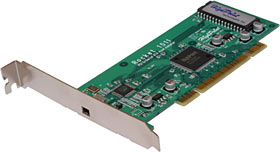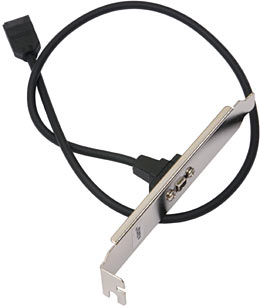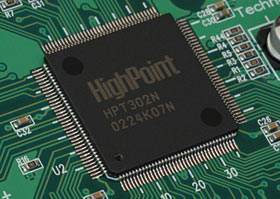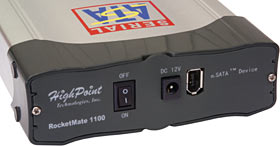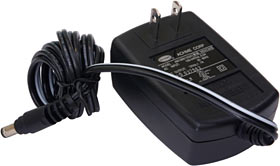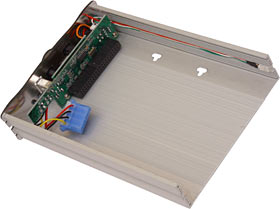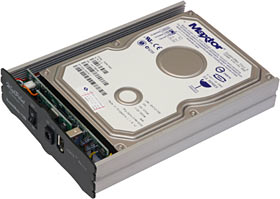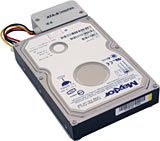
HighPoint Technologies RocketMate 1100 and Rocket 1511
Review date: 4 September 2003.Last modified 03-Dec-2011.
Fast external storage used to be hard to find.
SCSI did the job, but SCSI drives aren't cheap. You also can't count on some randomly chosen computer having a SCSI adapter, and you usually have to power down a computer to add a SCSI device. So SCSI isn't good for general purpose carry-around storage.
Most PC hard drives (and most Macintosh hard drives these days, too) are IDE/ATA devices, using the time-honoured Parallel ATA (PATA) interface, with its 40 or 80 wire ribbon cables. ATA drives are cheap, fast and capacious, but they're no use for external storage, either - well, not without "bridge" hardware to translate their interface into some other one.
PATA has quite strict cable length limits (they're not meant to be longer than 18 inches from the connector on the motherboard; 24 inches is pushing your luck), the cables are cumbersome ("rounded" PATA cables aren't a whole lot better than flat ones), and you still have to turn the computer off to plug and unplug drives.
Nowadays, we have FireWire and USB 2.0. Both interfaces are acceptably fast (tens of megabytes per second), allow hot-plugging of devices (no turning off or rebooting needed), and permit respectable cable lengths.
Lots of recent Macs have FireWire ports, as do some PCs. Practically every PC or Mac from the last few years has at least USB 1.1 ports, which hold USB 2.0 devices down to only about a megabyte per second, but that's still better than nothing. For people only interested in Mac compatibility, FireWire is probably the best choice; Macs can even boot from FireWire devices. For PC users who want the widest compatibility, though, USB is the way to go. Either way, you just get an external USB or FireWire drive box with ATA bridge hardware (or one of these things) and a suitable PATA drive, and you're done.
Now there's Serial ATA (SATA), though. It's what forced us to create the retronym PATA; it's fundamentally the same as ribbon-cable ATA (as my penance for that oversimplification, here's a PDF format SATA technology backgrounder), but uses a much slimmer and simpler serial cable with far fewer conductors.
SATA does away with PATA's master/slave two-drives-per-cable system; this is a good thing. SATA can only have one drive hooked up to each motherboard or controller card connector, but the cables are easy to deal with and can be up to a metre long.
SATA was just breaking into the PC marketplace a year ago, when I wrote this; nowadays, many motherboards have at least a couple of SATA ports along with their PATA connectors, and SATA drives are easy to find in the retail stores and not a lot more expensive than their PATA cousins. So SATA, with its lengthy cables and easy compatibility, looks like a real option for removable storage.
HighPoint Technologies certainly think so, because they've been heavily promoting their External Serial ATA ("e.SATA") system. It aims to make SATA into an easy to use external storage option. And it pretty much does.
It also, according to HighPoint at least, aims to "kill" SCSI and USB 2.0. This, I think, is stretching it a bit.
On with the show!
The hardware
This is HighPoint's simplest e.SATA controller card, the Rocket 1511. It's got only one connector, for only one drive, but that's all a lot of users are likely to need.
If you've got a PC with enough unused SATA ports on its motherboard for the number of e.SATA devices you want, then you don't need a separate controller card...
...because you can just use a "B11" rear expansion slot bracket, which has a cable that goes to your internal SATA socket.
The weirdest thing about the Rocket 1511, and the B11, is the connector they use. It's not a SATA socket. It's a four pin FireWire socket.
Hold that thought.
The Rocket 1511's powered by HighPoint's own HPT302N. This is a basic UDMA/133 controller chip. That's right - PATA, not SATA. There's a Marvell 88i8030 Serial ATA bridge chip on the card, too, to handle translation.
When SATA was new, pretty everything that claimed to be SATA was actually bridged PATA, and there's still plenty of that going on. Which is fine. It works, and there's no noticeable performance penalty.
Here's HighPoint's nicest e.SATA drive box, the RocketMate 1100. There's a RocketMate 1000 as well; as far as I can tell, the only difference is that the 1100 has more metal in it, with an aluminium tray for the drive to mount in and a slide-on aluminium body around it.
The RocketMate has plastic end caps, and rubber feet on one side, so you can stand it up if you like. Modern hard drives don't care what orientation you use them in. There's also one understated little status light on the front of the RocketMate; it glows orange when the box is powered up and flashes green to indicate drive activity. Which is a bit backwards, but hey, whatever.
On the back of the RocketMate box, there's a switch, a DC input jack, and another FireWire socket - this time the usual large six-pin type.
The electrical difference between six- and four-pin FireWire connectors is that the little ones don't have power wires. Neither does a SATA cable, so this isn't a problem; the four conductors that are connected through a four-to-six-pin FireWire cable are quite enough for SATA.
This configuration also means that the two power-wire contacts on the RocketMate's socket have no reason to be connected to anything. Which, I say with a trusting, bunny-like expression on my face, means they presumably aren't.
This is a good thing, because people are definitely going to connect RocketMates to genuine FireWire cables by accident from time to time, and it's seldom a good idea to connect power to pins on a connector that aren't expecting it. With the power pins connected to nothing, no harm should befall a mis-connected RocketMate, or the FireWire controller at the other end of its cable.
The plugpack that comes with the RocketMate is, as is common these days, a lightweight 100-to-240-volt multi-frequency world-compatible switchmode unit. Switchmode supplies can not only be made in multiple input voltage versions, but also waste less power when plugged in but doing nothing.
HighPoint sell e.SATA Value Kits that includes one RocketMate 1000 or 1100 enclosure and one B11 bracket; there's also an e.SATA Upgrade Kit with one enclosure and one Rocket 1511.
Here in Australia, Aus PC Market sell the RocketMate 1100 version of the Upgrade Kit for only $AU198, including Australian delivery.
Using it
Undo two screws and you can slide out the guts of the RocketMate case; it's got simple screw mounts for the 3.5 inch PATA drive of your choice.
Both the body of the case and the inner tray on which the drive mounts are made from aluminium. The inner tray has heat-sink-ish grooves on it, but there's no cooling fan, so they're pretty much just decorative.
All that metal ought to keep a 7200RPM drive pretty happy inside the RocketMate 1100, though I'd be slightly nervous about running it all day with not the slightest breath of assisted ventilation. It got toasty warm during my tests, but modern hard drives can survive extended operation at alarmingly high temperatures.
I have seen badly designed external drive boxes; this is not one of them. You plug in the two connectors for the drive, you screw it in place through the bottom of the tray, you slide the body of the case back into place, and that's it. Nothing bunches, catches, pulls taut or fails to line up.
For testing, I used another of the 120Gb Maxtor DiamondMax Plus 9s that I used for my DriveDock review the other day. The Plus 9 is a fast 7200RPM PATA drive, and also excellent value for money at the moment (as I write this, AusPC have it for less than $AU200, delivered).
Plugged into one of my Abit IC7's onboard SATA connectors, the RocketMate-d DiamondMax was fast. It actually benchmarked better than an identical DiamondMax running from the internal PATA controller, although that internal drive is only running in UDMA/100 mode, because of another drive on the cable.
Still, the difference was larger than can be accounted for just by the trivial headroom difference between UDMA/100 and 133. For sequential reads and writes, the e.SATA DiamondMax scored better than 20% faster - about 48 megabytes per second for each, versus about 38.5Mb/s for the PATA drive.
What's this mean in the real world? Not much. If you're beating the heck out of a drive with some disk-intensive task like video editing or database work or what have you, then 20% more speed will matter to you. Most people aren't doing that, though, and both of these drives shift data speedily enough to suit anyone. The difference between 21 and 27 seconds per gigabyte is easily measurable, but unlikely to be a source of inconvenience.
For random reads and writes, by the way, both drives managed pretty miserable performance. Changing interface doesn't change seek speed, and if you're hunting all over the disk for lots of little files (or lots of fragments of big files) you can't expect much from any consumer disk - or any single disk, really. You need a RAID array, or at least an expensive controller with a huge cache, to support worst-case random access at anything much above 10Mb/s.
Anyway, the take-home message is: It's fast. There's no performance penalty from the e.SATA system.
And here endeth the complimentary portion of the review. Let's go all Claw Shrimp on this thing now.
Claims and reality
You know what I don't like? Marketing. Oh, sure, I run ads on my home page, but that's pimping, not marketing. The difference is style, people.
Whoever it was at HighPoint who made their e.SATA-promoting "Who killed..." pages about SCSI and USB 2.0 had, I think, trodden in some marketing out there somewhere, and was now tracking it all over the carpet.
HighPoint say, for starters, that e.SATA supports speeds of up to 150 megabytes per second, way faster than poor old USB 2.0 down there below 60Mb/s.
Well, OK, 150Mb/s (or, at least, 150 million bytes per second) is the ceiling speed of the first generation SATA devices we're using now. But with a drive no faster than UDMA/133 in your e.SATA box, you obviously can't get all of that speed. And, more importantly, no consumer drive is yet capable of real sustained transfers a lot faster than 50 megabytes per second. The 200Gb-plus monster drives are pushing the 60Mb/s line, but that's all, folks.
HighPoint's Spin Department also says that e.SATA is "not bogged down by other devices attached to the SATA controller". In other news, my body is not bogged down by large and unsightly muscles. Sure, SATA's one-device-per-wire design means each drive gets as big a share of the available bandwidth as it possibly can, but it's nice to be able to connect more than one device to a cable, if only to avoid a spray of separate wires coming out of the back of your computer.
And then, there's hot-swap, which is one of the reasons why e.SATA's supposed to be killing SCSI.
Hot-swap, to a server operator, means the ability to yank a failed drive from a running server's RAID array, slap in a new one, and have the new drive's data automatically rebuilt onto it, without shutting the server down. Better RAID controllers even allow "hot-spare", where spare drives can be pre-installed and sit there waiting until they're needed to replace a fallen comrade, so the whole operation can happen while the server admin sleeps.
Hot-swap, to the average computer user, now means something a bit different. It means the ability to plug and unplug devices whenever you like, without turning your computer off. USB and FireWire both let you do this.
SATA does not, natively, support hot-swap of any kind. It's a lot more civilised than PATA, which can thork your computer if you yank a cable, but you can't swap drives at will.
I tried yanking the RocketMate's data cable in the middle of a file transfer operation. Nothing awful happened. The transfer froze, of course, and eventually failed; I tried plugging the drive back in before the transfer timed out, but Windows XP failed to recognise its return.
You can get special SATA controllers that support hot swap for RAID operation; HighPoint say the RocketMate boxes work with them. HighPoint's own e.SATA-connectored RocketRaid 1542 and 1544 support hot swap, for instance (well, the 1542 manual says that it does; HighPoint's manuals page doesn't have one for the 1544 at the moment). This is only for hot swapping of a failed drive in an array, though; everyday single drive hot plugging still won't work.
The reason for this is that HighPoint's ATA RAID controllers, like those made by their competitor Promise Technology, are not true hardware RAID controllers, which handle the splitting and mirroring of data between drives themselves. Instead, these cheap controllers just write RAID set data to the disks, and then turn the actual RAID work over to their drivers (which can be bad news for people who aren't running Windows).
There are heavier-duty IDE RAID options that don't involve the OS in the operation, but HighPoint and Promise are basically not offering much that Linux or server-level Windows users can't do in software with any old controller. Promise might possibly have some more hardware-y products at the moment, but "hardware XOR engine" doesn't say "proper hardware RAID card" to me.
For these mainly-software controllers, hot-swap functionality is implemented in the special RAID drivers, and those drivers only do anything when you've set up a RAID array. When the controllers are in separate-drives mode, they work as regular ATA controllers. That means the baseline feature set, with no hot swap.
So e.SATA is a turn-off-to-swap-drives system, like SCSI (which can also do hot swap, if you use the right controller and drive boxes/racks). HighPoint are telling the truth when they say that "Multiple Rocket Mate external disk enclosures can be used with a single e.SATA port", but you have to reboot in between.
While we're on the subject of RAID - the "Who killed SCSI" page goes on to say that "4-channel e.SATA controllers can move data at speeds up to 600MB/s".
Can they, now? Through what?
Maybe this claim will be true, when HighPoint release a 64 bit, 133MHz PCI-X controller card. At the moment, all but two of their SATA cards use good old fashioned 32 bit 33MHz standard PCI. 1520 and 1511 are alleged, on their spec sheets, to support 66MHz, but they're not "long slot" 64 bit cards, and they don't support 133MHz operation, and they're not even RAID cards anyway.
If you've got a regular PC without up-rated PCI slots, then even if the SATA drives are the only drives on the bus (regular PATA drives use the PCI bus too), the absolute maximum bandwidth they can access is 133 million bytes per second, or 127 1,048,576-byte megabytes per second.
In reality, PCI can't actually move anything like that much user data per second. But even if it could, and even if you're running at 66MHz, HighPoint would still be, well, lying, when they say that e.SATA RAID can shift 600 megabytes per second.
SCSI has exactly the same problem, of course. Ultra320 SCSI isn't any faster than much older SCSI flavours if the SCSI adapter doesn't have a big fat bus to move data through. But that doesn't entitle HighPoint to make stuff up.
An alternative
HighPoint are not the only makers of external SATA devices. You can get other external boxes with SATA options, and with a better feature set than e.SATA.
Aus PC Market, for instance, stock this thing.
It's an external drive box that takes an ordinary PATA drive, like the RocketMate, but it's got a normal SATA connector on the back, and a USB 2.0 connector. To plug it in via SATA, you just run a regular one metre SATA cable out any old hole in the back of your computer. Take out an expansion slot cover, or punch out one of the blanks for a serial or parallel port that you don't have, and voila, one hole.
This isn't as elegant as the rear-socket HighPoint arrangement, but it's not what you'd call hideous. And when you want to take the box somewhere else, there's the USB connector. Somewhat slower in USB 2.0 mode, much slower if you have to use USB 1.1, but at least it'll work.
It's not expensive, either - $AU132, including Aussie delivery.
Overall
E.SATA is a simple concept which HighPoint are overpromoting.
There's nothing wrong with making an external storage system using SATA/PATA bridge hardware, cheap commodity PATA drives and a cable from one or another SATA controller - but that's all this thing is.
It does not "kill" SCSI or USB 2.0 for performance, it does not provide the simple everyday non-RAID hot-swap functions that're a big selling point for USB and FireWire, and it doesn't even provide easy compatibility with any random computer. Even if a PC is new enough to have SATA ports on its motherboard, it won't have one of e.SATA's goofy mini-FireWire sockets on its back panel. It'd be the work of a few minutes to run a SATA cable out from an internal socket, if one's available, to use a box like the one AusPC are selling. But you can't plug an e.SATA box in that way.
I'm also a little concerned about the durability of the four pin FireWire plug, which isn't the ideal connector to be fumbling with on the back of a computer. The RocketMate case could do with somewhat better ventilation as well - a little fan, or just a grille.
These complaints aren't much more than quibbles, though. On its own merits, e.SATA is OK.
It just doesn't live up to the HighPoint hype.
Review e.SATA gear kindly provided by HighPoint Technologies.
